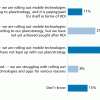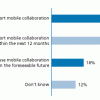Strategic advice to leverage new technologies
Technology is at the heart of nearly every enterprise, enabling new business models and strategies, and serving as the catalyst to industry convergence. Leveraging the right technology can improve business outcomes, providing intelligence and insights that help you make more informed and accurate decisions. From finding patterns in data through data science, to curating relevant insights with data analytics, to the predictive abilities and innumerable applications of AI, to solving challenging business problems with ML, NLP, and knowledge graphs, technology has brought decision-making to a more intelligent level. Keep pace with the technology trends, opportunities, applications, and real-world use cases that will move your organization closer to its transformation and business goals.
Recently Published
For the past three or four years, mobility has continually ranked near the top of the list of "must have" capabilities when it comes to corporate technology adoption plans. This begs the question: how do organizations view the success of their mobile technology efforts to date? A Cutter Consortium survey (conducted in July–October 2014) that asked 49 organizations about their mobile technology adoption and implementation practices helps shed some light on this question.
Although social media tools like Facebook and Twitter were initially developed for personal communication, businesses quickly became enamored with social media as a mode of expressing their own messages and selling products or services. Numerous companies have one or more social media accounts today, handling everything from product launches to corporate damage control.
Over the past few years, the Internet of Things (IoT) has generated a lot of hype, touting how embedded sensors combined with mobile technologies will lead to a multitude of connected devices and services (all generating a deluge of data), which will open up a gold rush of opportunities in the consumer, business, technology, and industrial worlds. We've also learned that the IoT is not just about sensors and a lot of data and analytics; it also involves the application of new technologies including drones, wearable computers, and smart networks, as well as new practices such as predictive maintenance.
I always look forward to attending Agile conferences. It is a great place to hear speakers sharing their experiences and secret recipe behind their success. However, I have come to realize over a period of years that what I hear at conferences needs to be taken with a pinch of salt, analyzed well before implementing in our organizations. In this Advisor, I would like to share a few tips to keep in mind while borrowing new ideas and rolling out in the organization. There are some situations that could do more harm than being useful.
A good way to make predictions is to recognize current trends and then extrapolate them into the future. The longer the trends, the more confident you can be about the predictions. Thinking about software development processes, we see two long-term paths that software development has taken. These paths are the basis of both our joint prediction for the coming year and the kind of holistic consulting we will focus on in 2015.
In a recent Executive Report, we looked in detail at how contemporary architecture teams use roadmaps. Here, we summarize some of the key learning points -- drawn from the experiences of organizations with widespread use of roadmaps -- to provide tips and suggestions for creating better and more useful EA roadmaps (see "EA Roadmaps and Strategic Vectors"):
People made decisions for many millennia without the benefit of IT, and it's not self-evident that we make our really big decisions in the computer age consistently better than before. Smaller decisions, in relatively information-rich situations, are another matter. But IT, properly used, has become and will continue to be important to decision makers in critical ways:
Enterprise Mobility: Part I -- Collaboration Trends
This Executive Update examines survey findings pertaining to the status of mobile collaboration in the enterprise; types of mobile collaboration platforms organizations use (i.e., on premise or cloud-based); and trends in functionality organizations seek to provide with their mobile collaboration platforms











